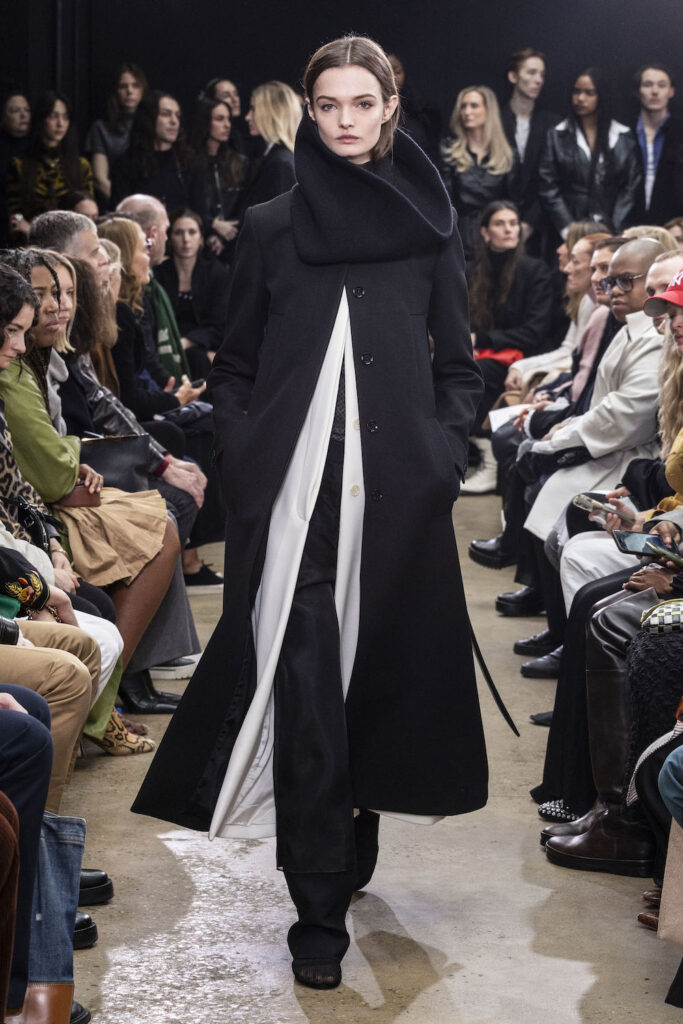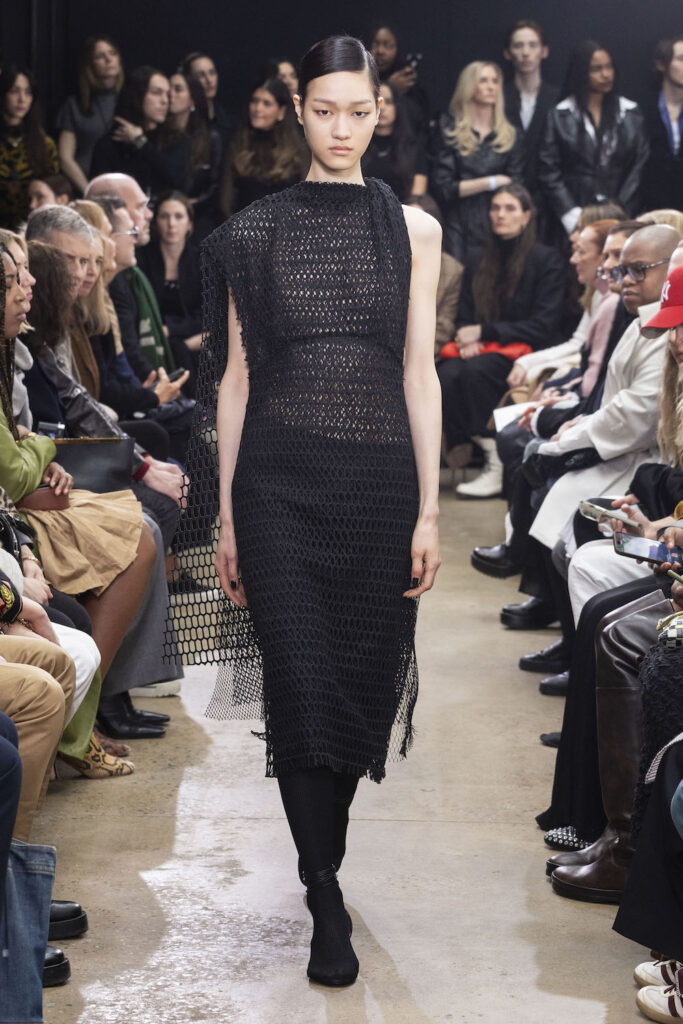What is it about our current climate that has everyone taking stock? For so many designers, it’s time to take a look back at what they’ve accomplished in order to move forward in these uncertain times. Suddenly, “new-new” isn’t necessarily as magical as it was yesterday. The most resolute of us are trying to stay steady in this topsy-turvy world.
Proenza Schouler had one of their best collections, a pure play on shape and refined layers, which became clear when the duo realized they wanted to take a different approach. It was the strong opening punt (I was writing this on Superbowl Sunday, couldn’t help the reference) for a New York Fashion Week needed to throw off the ennui enveloping it like bad fashion particulates.
“Back in the day everything was about a totally new thing,” said Lazaro Hernandez, thinking of the early 2000s when the duo started. “Now we’re really just trying to think about the woman,” added Jack McCollough.

Photo courtesy of Proenza Schouler
Photo courtesy of Proenza Schouler
Photo courtesy of Proenza SchoulerIt looked luxurious, artistic, and comfortable, not in the way mac and cheese is satisfying in winter but more like caviar and pasta. Just those two ingredients provide everything you’ll need to feel safe and nourished. “It’s about beauty, enveloping layers, comfort, soulful,” explained Hernandez.
They achieved this by subtracting all prints but one that looked like splattered paint on jeans. There was nothing superfluous; all the better to play up the handbags the models clutched. Much of the work was done on Friday, the night before the show, the duo said. What was left were sharply-tailored black wool jackets and coats, an opulent fur vest, a tent dress in gold with simple black straps and knit layers wrapping the body in blue the shade of a blue winter sky.

Before there were the Proenza Schouler “boys” (now men) Jack and Lazaro, there were the “boys” — Mark and James. Mark Badgley and James Mischka have been at the game for 35 years; in the last ten their presence at the shows has been intermittent. But the boys are back. I hope they’re back to stay. They bring what fashion week needs, a little frothy fantasy. The other thing it needs would be hard-edged excitement but that, of course, is not Badgley Mischka. Elegance! Color! Joy! That’s their brand.
If you want to walk in a fuchsia cloud (cinched with a black belt), you can. If you desire to be a screen siren, you can go at it. Silver sequins bathed a floor-length tailored stunner worthy of Jean Harlow. They were generous with beading and embroidery on the shoulders of jackets and necklines of dresses which added up to maximum glamor.

Photo courtesy of House Photographer LLC
Photo courtesy of House Photographer LLC
Photo courtesy of House Photographer LLCBadgley Mischka used the show — sprinkled with Park Avenue socialites and a handful of entertainers including the actor Eva Marcille — to introduce they’re new fragrance offerings Cap D’Antibes and Côte D’Azur. The timing is perfect as they ride the unexpected juggernaut that is ABC’s The Golden Bachelor. It was so much more than a successful TV show, it was a cultural moment that the designers participated in on-camera dressing the bride and her bridesmaids.
Speaking of moments, Tommy Hilfiger called his show “A New York Moment” an ode to the city and the state he was born in. He chose as his venue a Manhattan icon: Grand Central Station. Specifically The Oyster Bar. Champagne flowed, he laid down the blue carpet (over the usual floor tile) and riffed on New York prep themes in fluid wide leg pants, modified peacoats, boxy blazers, and long car coats for both men and women, all in hues of khaki, navy and white. “We have a new silhouette, a fuller leg, more volume,” said Hilfiger, who started a collaboration with artist Greg Lauren (Ralph’s nephew), last season.

Photo courtesy of Tommy Hilfiger
Photo courtesy of Tommy HilfigerIt seemed an odd pairing given historic competition between the two brands. “We’re friends,” he said of the relationship with Greg. “I haven’t heard from Ralph yet,” he deadpanned.
Misty Copeland was front row at Bach Mai’s earnest show, wearing one of the designer’s shiny, sexy dresses. The Fashion Group International award-winner’s show was a hot ticket and drew fellow emerging designers like Teddy Von Ranson. This was not predictable evening wear. Mai’s approach is sharp and fierce, a kind of “ruins among the romance.”

Photo courtesy of Launchmetrics SpotlightThere was a black mesh bodysuit, a sequin bandage bodysuit with low-slung pants — both baring plenty of skin. The opening look, a romantic opera coat over a blouse with multicolor necklace fringes like a maypole and black cadet trousers looked great.
Diaphanous floral dresses encapsulated the designer’s feel for special colors like mauve and burnt orange. With more resources and time, Mai is likely to emerge as a significant force in the industry.

Photo courtesy of Launchmetrics SpotlightRodney Epperson showed one of the most refreshing and intriguing collections so far. The designer long ago figured out who he wants to be as a brand and sticks to it. In this case the clothes were remarkable. Twisted and wrapped jackets were layered over loose skirts or languid trousers in a state of studied undoneness. Deconstruction and Eastern dress dissolved into Western urbanity.
Set amid the lobby of the bustling Edison Hotel in the heart of Manhattan’s theater district, Epperson brought a cinéma vérité quality to show week, with tourists in the lobby stopping to gawk and comment on the show. Models of varying sizes, ages, races, and genders walked the runway, then posed on upholstered green couches reading books like Zora Neale Hurston’s Their Eyes Were Watching God, and Men of Color, the 1988 book by fashion trailblazer Lloyd Boston.
For a certain urban shopper, Catherine Holstein, designer of Khaite, is so good at providing the one wardrobe item we want to stock our closet with. She showed off several in her latest outing — a licorice black blazer with wide-lapel collar, a generous wine leather coat, a skirt with a gathered waist. This doesn’t though, translate to a collection con brio.
There were far too many pieces that were derivative, a problem that has followed Khaite in previous seasons when it was Helmut Lang or Halston who was in the room. It would be nice to clearly communicate the brand DNA. You can be a true innovative brand which stands for a promise shoppers can rely on or be a great showroom or wardrobe resource. But it’s also possible to be both. It’s not always easy and sometimes it takes time.


